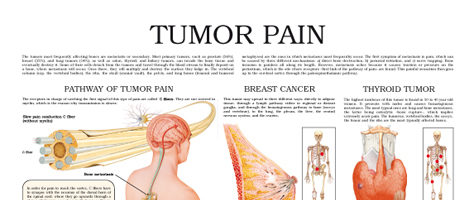
EnglishSpanish
The tumors most frequently affecting bones are metastatic or secondary. Most primary tumors, such as prostate (36%), breast (32%), and lung tumors (14%), as well as colon, thyroid, and kidney tumors, can invade the bone tissue and eventually destroy it. Some of their cells detach from the tumors and travel through the blood stream to finally deposit on a bone, where metastasis will occur. Once there, they will multiply and destroy the surface they lodge in. The vertebral column (esp. the vertebral bodies), the ribs, the skull (cranial vault), the pelvis, and long bones (femoral and humeral metaphyses) are the ones in which metastases most frequenthy occur. The first symptom of metastasis is pain, which can be caused by three different mechanisms: a) direct bone destruction, b) periostal irritation, and c) nerve trapping. Bone invasion is painless all along its length. However, metastasis aches because it causes traction or pressure on the periostium, which is the site where receptors –first link of the pathway of pain- are found. This painful sensation then goes up to the cerebral cortex through the paleospinothalamic pathway.
Los tumores que con mayor frecuencia afectan al hueso son los metastáticos o secundarios. La mayoría de los tumores primarios tienen la capacidad de invadir el tejido óseo provocando la destrucción del mismo, siendo los más comunes los tumores de próstata (36%), mama (32%), pulmón (14%), colon, tiroides y riñón. Algunas células de estos tumores se desprenden y viajan por el torrente sanguíneo, luego se depositan en el hueso produciendo la metástasis, donde tienen la capacidad de multiplicarse y destruir la superficie donde se asentaron. Los huesos en los que con mayor frecuencia se instalan las metástasis son: la columna vertebral (especialmente los cuerpos vertebrales), las costillas, el cráneo (bóveda), la pelvis, y los huesos largos (metáfisis de fémur y húmero). La presencia de estas metástasis se exterioriza por dolor. Este es producido por tres mecanismos distintos: a) destrucción directa del hueso, b) irritación perióstica, y c) atrapamiento nervioso. La invasión del hueso no duele en toda su extensión. Solo duele la metástasis que produce tracción o presión del periostio, que es el lugar donde se encuentran los receptores, primer eslabón de la vía del dolor. La sensación dolorosa luego asciende a la corteza cerebral por la vía paleoespinotalámica.




